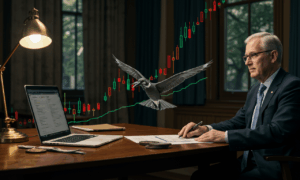The latest decision on Federal Reserve interest rates has sent a clear message to consumers and investors alike: don’t expect borrowing to get cheaper anytime soon. While the central bank decided to hold rates steady for now, the real story lies in their updated forecast, which paints a picture of a more cautious approach to the economy. In this article, we’ll break down exactly what the Federal Reserve announced, why they made this decision, and most importantly, how it directly impacts your wallet, from your savings account to your mortgage payments.
The Status Quo: What Did the Federal Reserve Announce?
In its most recent meeting, the Federal Open Market Committee (FOMC), which is the arm of the Federal Reserve responsible for setting monetary policy, voted to maintain the federal funds rate in its current range of 5.25% to 5.50%. This marks the highest level in over two decades and was a move widely anticipated by economists.
But what exactly is the federal funds rate? Think of it as the interest rate at which commercial banks lend money to each other overnight. While you don’t pay this rate directly, it serves as a foundational benchmark that influences a vast array of other borrowing costs throughout the entire financial system. When the federal funds rate is high, it becomes more expensive for banks to borrow, and they pass those higher costs on to you in the form of:
- Higher interest on credit cards
- More expensive car loans
- Higher rates for mortgages
The Fed’s primary tool for fighting inflation is adjusting this rate. By making borrowing more expensive, it encourages both consumers and businesses to spend less, which helps to cool down demand and, in theory, bring prices under control. The decision to hold rates steady signals that the Fed believes its current policy is restrictive enough but that the fight against rising prices isn’t over yet.
Reading the Tea Leaves: A Shift in Future Expectations
The most significant piece of news wasn’t the decision to hold rates steady, but the new economic projections released by the committee. A key component of this is the “dot plot,” a chart that anonymously maps out where each of the 19 Fed officials believes interest rates should be at the end of the coming years.
Previously, the dot plot had indicated an expectation of three quarter-point rate cuts in 2024. However, the updated forecast shows a major shift: the median projection now points to only one rate cut for the remainder of the year. This is a “hawkish” pivot, a term used in finance to describe a tougher stance against inflation, even if it means keeping borrowing costs higher for longer. This change in outlook tells us that the central bank is less confident about inflation returning to its 2% target quickly and is preparing to maintain its tight monetary policy for an extended period.
Understanding these future projections is crucial, as financial markets often react more to what the Fed is expected to do than what it has already done. The signal of fewer cuts has significant implications for the broader economy.

Why the Cautious Stance? The Stubborn Inflation Problem
The Federal Reserve’s cautious approach stems from one primary concern: persistent inflation. While inflation has cooled considerably from its peak in 2022, recent data has shown that the final stretch of getting it back down to the 2% target is proving difficult. Officials have described this inflation as “sticky.”
The Fed is analyzing a few key areas:
- Core Inflation: This metric strips out volatile food and energy prices to give a clearer picture of underlying price trends. While it has been decreasing, it remains well above the target level.
- The Labor Market: The job market has remained surprisingly strong, with consistent job growth and low unemployment. While good for workers, a very hot labor market can contribute to wage pressures, which in turn can fuel inflation. The Fed is aiming for a “soft landing”—cooling the economy enough to tame inflation without triggering a major recession and mass layoffs.
- Consumer Spending: Americans have, for the most part, continued to spend, supported by wage gains and savings. The Fed is watching to see if higher interest rates will eventually lead to a more significant slowdown in consumer demand.
Ultimately, the Fed has stated it needs “greater confidence” that inflation is moving sustainably down to its 2% goal before it will begin to lower interest rates. The latest data hasn’t provided that conclusive evidence, prompting the committee to delay its timeline for rate cuts.
How the Fed’s Decision Affects Your Personal Finances
This high-level policy has very real-world consequences for your financial life. Here’s a practical breakdown of what “higher for longer” interest rates mean for you:
- Savings and CDs: This is the silver lining. With the federal funds rate remaining high, banks will continue to compete for your deposits by offering attractive annual percentage yields (APYs). High-yield savings accounts and certificates of deposit (CDs) will remain a great place to park your cash and earn a solid, low-risk return. If you’ve been meaning to optimize your cash reserves, now is an excellent time to explore your savings options.
- Mortgages and Housing: For prospective homebuyers, the news is less encouraging. Mortgage rates are not directly set by the Fed, but they are heavily influenced by its policy and expectations for future inflation. The signal of fewer rate cuts means that mortgage rates are likely to stay elevated, keeping home affordability a major challenge.
- Credit Cards and Other Loans: The annual percentage rates (APRs) on most credit cards are variable and tied directly to the prime rate, which moves in lockstep with the Fed’s rate. This means carrying a balance on your credit card will continue to be very expensive. The same applies to new car loans and personal loans.
- Investing: The stock market’s reaction can be complex. On one hand, higher rates can be a headwind for corporate profits, as borrowing becomes more expensive for businesses. On the other, the market can rally if it perceives the Fed is successfully managing the economy and avoiding a recession. Investors will be closely watching upcoming inflation data for clues about the Fed’s next move.
Frequently Asked Questions (FAQ)
Why doesn’t the Fed just cut interest rates to make my loan payments cheaper?
The Federal Reserve has a “dual mandate”: to achieve maximum employment and stable prices (i.e., low inflation). If they were to cut rates prematurely while inflation is still high, it could cause prices to spiral upwards again. This would erode the purchasing power of everyone’s money, hurting lower-income households the most. The Fed’s goal is to bring inflation back to its 2% target to create a stable economic environment for the long term, even if it means short-term pain in the form of higher borrowing costs.
If rates are high, is this a good or bad time for my investments?
It’s neither inherently good nor bad; it simply changes the landscape. High interest rates make lower-risk investments like high-yield savings accounts, money market funds, and bonds more attractive because they offer competitive returns. For the stock market, some sectors may struggle with high borrowing costs (like real estate or high-growth tech), while others may be more resilient (like established, cash-rich companies). It’s a time that emphasizes the importance of a diversified portfolio and a long-term investment strategy rather than trying to time the market based on the Fed’s next move.



